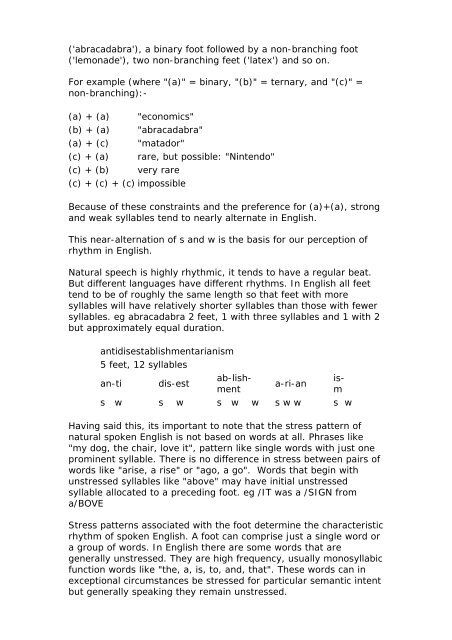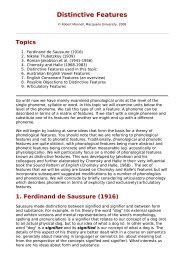The Syllable and the Foot : Summary - Speech Resource Pages
The Syllable and the Foot : Summary - Speech Resource Pages
The Syllable and the Foot : Summary - Speech Resource Pages
You also want an ePaper? Increase the reach of your titles
YUMPU automatically turns print PDFs into web optimized ePapers that Google loves.
('abracadabra'), a binary foot followed by a non-branching foot<br />
('lemonade'), two non-branching feet ('latex') <strong>and</strong> so on.<br />
For example (where "(a)" = binary, "(b)" = ternary, <strong>and</strong> "(c)" =<br />
non-branching):-<br />
(a) + (a) "economics"<br />
(b) + (a) "abracadabra"<br />
(a) + (c) "matador"<br />
(c) + (a) rare, but possible: "Nintendo"<br />
(c) + (b) very rare<br />
(c) + (c) + (c) impossible<br />
Because of <strong>the</strong>se constraints <strong>and</strong> <strong>the</strong> preference for (a)+(a), strong<br />
<strong>and</strong> weak syllables tend to nearly alternate in English.<br />
This near-alternation of s <strong>and</strong> w is <strong>the</strong> basis for our perception of<br />
rhythm in English.<br />
Natural speech is highly rhythmic, it tends to have a regular beat.<br />
But different languages have different rhythms. In English all feet<br />
tend to be of roughly <strong>the</strong> same length so that feet with more<br />
syllables will have relatively shorter syllables than those with fewer<br />
syllables. eg abracadabra 2 feet, 1 with three syllables <strong>and</strong> 1 with 2<br />
but approximately equal duration.<br />
antidisestablishmentarianism<br />
5 feet, 12 syllables<br />
an-ti dis-est<br />
ab-lishment<br />
a-ri-an<br />
ism<br />
s w s w s w w s w w s w<br />
Having said this, its important to note that <strong>the</strong> stress pattern of<br />
natural spoken English is not based on words at all. Phrases like<br />
"my dog, <strong>the</strong> chair, love it", pattern like single words with just one<br />
prominent syllable. <strong>The</strong>re is no difference in stress between pairs of<br />
words like "arise, a rise" or "ago, a go". Words that begin with<br />
unstressed syllables like "above" may have initial unstressed<br />
syllable allocated to a preceding foot. eg /IT was a /SIGN from<br />
a/BOVE<br />
Stress patterns associated with <strong>the</strong> foot determine <strong>the</strong> characteristic<br />
rhythm of spoken English. A foot can comprise just a single word or<br />
a group of words. In English <strong>the</strong>re are some words that are<br />
generally unstressed. <strong>The</strong>y are high frequency, usually monosyllabic<br />
function words like "<strong>the</strong>, a, is, to, <strong>and</strong>, that". <strong>The</strong>se words can in<br />
exceptional circumstances be stressed for particular semantic intent<br />
but generally speaking <strong>the</strong>y remain unstressed.
















